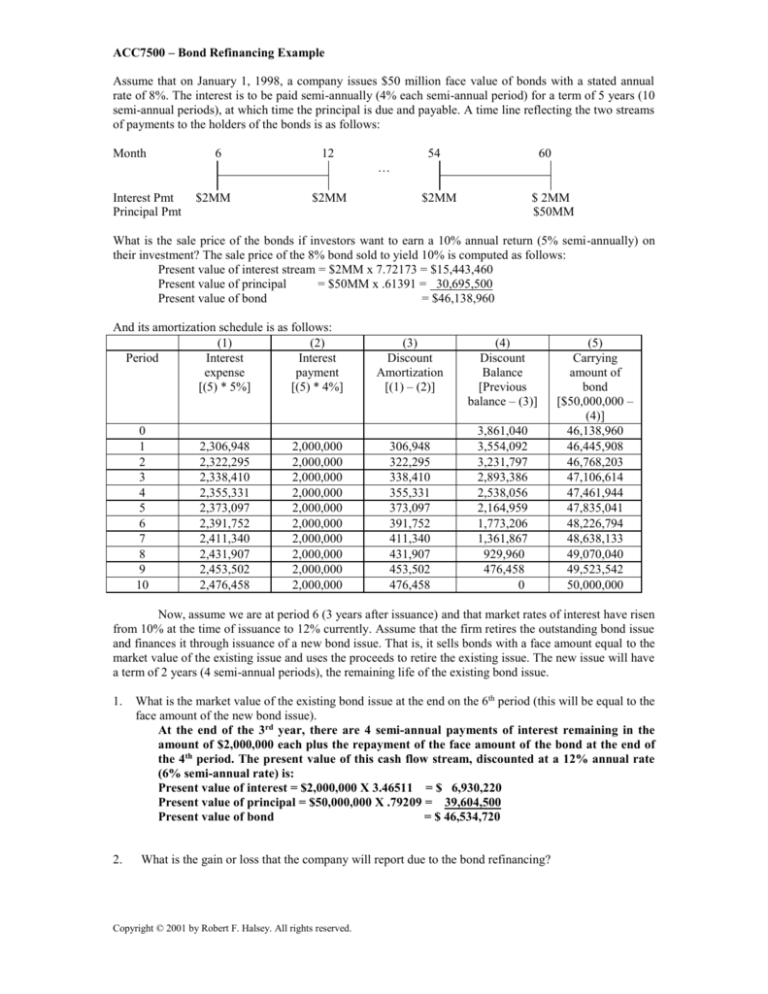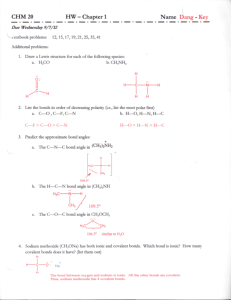
ACC7500 – Bond Refinancing Example
Assume that on January 1, 1998, a company issues $50 million face value of bonds with a stated annual
rate of 8%. The interest is to be paid semi-annually (4% each semi-annual period) for a term of 5 years (10
semi-annual periods), at which time the principal is due and payable. A time line reflecting the two streams
of payments to the holders of the bonds is as follows:
Month
6
12
54
60
…
Interest Pmt
Principal Pmt
$2MM
$2MM
$2MM
$ 2MM
$50MM
What is the sale price of the bonds if investors want to earn a 10% annual return (5% semi-annually) on
their investment? The sale price of the 8% bond sold to yield 10% is computed as follows:
Present value of interest stream = $2MM x 7.72173 = $15,443,460
Present value of principal
= $50MM x .61391 = 30,695,500
Present value of bond
= $46,138,960
And its amortization schedule is as follows:
(1)
(2)
Period
Interest
Interest
expense
payment
[(5) * 5%]
[(5) * 4%]
0
1
2
3
4
5
6
7
8
9
10
2,306,948
2,322,295
2,338,410
2,355,331
2,373,097
2,391,752
2,411,340
2,431,907
2,453,502
2,476,458
2,000,000
2,000,000
2,000,000
2,000,000
2,000,000
2,000,000
2,000,000
2,000,000
2,000,000
2,000,000
(3)
Discount
Amortization
[(1) – (2)]
306,948
322,295
338,410
355,331
373,097
391,752
411,340
431,907
453,502
476,458
(4)
Discount
Balance
[Previous
balance – (3)]
3,861,040
3,554,092
3,231,797
2,893,386
2,538,056
2,164,959
1,773,206
1,361,867
929,960
476,458
0
(5)
Carrying
amount of
bond
[$50,000,000 –
(4)]
46,138,960
46,445,908
46,768,203
47,106,614
47,461,944
47,835,041
48,226,794
48,638,133
49,070,040
49,523,542
50,000,000
Now, assume we are at period 6 (3 years after issuance) and that market rates of interest have risen
from 10% at the time of issuance to 12% currently. Assume that the firm retires the outstanding bond issue
and finances it through issuance of a new bond issue. That is, it sells bonds with a face amount equal to the
market value of the existing issue and uses the proceeds to retire the existing issue. The new issue will have
a term of 2 years (4 semi-annual periods), the remaining life of the existing bond issue.
1.
2.
What is the market value of the existing bond issue at the end on the 6th period (this will be equal to the
face amount of the new bond issue).
At the end of the 3rd year, there are 4 semi-annual payments of interest remaining in the
amount of $2,000,000 each plus the repayment of the face amount of the bond at the end of
the 4th period. The present value of this cash flow stream, discounted at a 12% annual rate
(6% semi-annual rate) is:
Present value of interest = $2,000,000 X 3.46511 = $ 6,930,220
Present value of principal = $50,000,000 X .79209 = 39,604,500
Present value of bond
= $ 46,534,720
What is the gain or loss that the company will report due to the bond refinancing?
Copyright © 2001 by Robert F. Halsey. All rights reserved.
The company will pay $46,534,720 to redeem a bond that is on its books at a carrying
amount of $48,226,794. The difference of $1,692,074 is reported as a gain on redemption, an
extraordinary item (net of tax).
3.
Although our firm reports an accounting gain on the redemption of bonds, has the company actually
realized a true economic gain?
In this case, the firm will issue bonds with a coupon rate of 12% (6% semi-annually) in the
amount of $46,534,720. Since we assume that the bonds are sold with a coupon rate equal to
the market rate, they will sell at par (no discount or premium). The interest expense per sixmonth period, therefore, will be equal to the interest paid in the amount of $2,792,083
($46,534,720 * 6%). Total expense for the 4 period life of the bond will be $2,792,083 X 4 =
$11,168,333. That amount, plus the $46,534,720 face amount of the bonds the firm will repay
at maturity, results in total bond payments of $57,703,053. Had the firm not redeemed the
bonds, it would have paid 4 additional interest payments of $2,000,000 each plus retirement
of the face amount of $50,000,000 at maturity, for total bond payments of $58,00,000. On the
surface, then, it appears that the firm is able to save $296,947 by redeeming the bonds and
has realized a true economic gain.1
This is, however, misleading. The firm’s “gain” consists of two parts. First, its
interest payments increase by $792,083 per year ($2,792,083 - $2,000,000). And second, the
face amount of the bond that must be repaid in 4 years decreases by $3,465,280 ($50,000,000
- $46,534,720). In order to evaluate whether a true gain has been realized, we must consider
the present value of these cash outflows and savings.
The present value of the increased interest outflow, a 4 period annuity of $792,083
discounted at 6% per period, is,
Present value cost of increased interest outflow = $792,083 * 3.46511 = $2,744,655
The present value of the reduced face amount the firm must repay at maturity, $3,465,280 4
periods hence, is
Present value benefit of decreased bond repayment = $3,465,280 * .79209 =
$2,744,814
So, has the firm realized a true economic gain? The answer is no. The present value of the
increased interest payments offsets the present value of the decreased amount that must be
paid at maturity and the present value of the net savings is zero. 2
Why, then, does application of current accounting principles result in the
recognition of a gain? The answer lies in our use of historical costing. Bonds are reported at
amortized cost, that is, the face amount less any applicable discount or plus any outstanding
premium. These amounts are a function of the selling price of the bond, its market value at
the time of sale, and are fixed for the duration of the bond. Market prices for bonds,
however, vary continuously with changes in market rates of interest. Firms do not adjust the
carrying amount of their bond liabilities for these changes in market value. As a result, when
bonds are redeemed, their carrying amount will differ from their market value and GAAP
requires the recognition of a gain or loss equal to this difference to be recorded upon
redemption of the bonds.
Although marketable securities accounted for as “trading” or “available-for-sale”
are reported on the balance sheet at current market values, the same is not true for bonds
and other long-term liabilities. This information might be relevant, however, for investors
and creditors in their analysis of the firm as it would provide an indication of unrealized
gains and losses similar to that reported for marketable securities. Fortunately, GAAP does
require companies to provide information about the current market values of their longterm liabilities in footnote disclosures. 3 Remember, however, that these current market
values are not reported on the balance sheet and changes in these market values are not
1
Notice, also, that the total interest expense on the new issue will be $3,168,333 ($11,168,333 $8,000,000) more than it would have recorded under the old bond issue. So, it is recording a present gain
but will also incur future higher interest costs.
2
The two amounts differ by $158, which is due to rounding errors in the use of 5 significant digits.
3
SFAS No. 107, “Disclosures About Fair Values of Financial Instruments,” Norwalk, CT: FASB, 1991.
Copyright © 2001 by Robert F. Halsey. All rights reserved.
reflected in net profit. Analysts must make their own adjustments to the balance sheet and
income statement based information contained in the notes.
Copyright © 2001 by Robert F. Halsey. All rights reserved.









